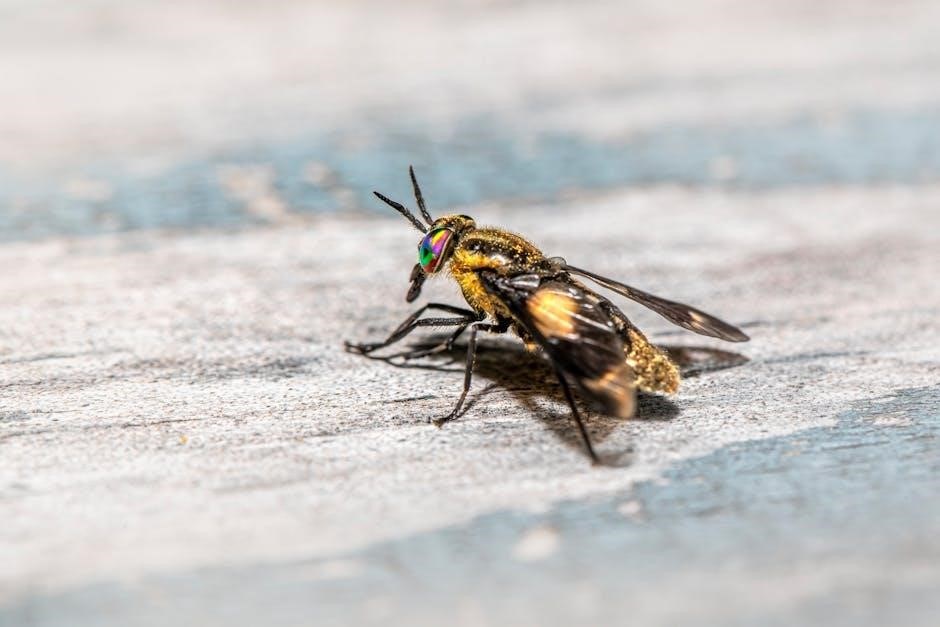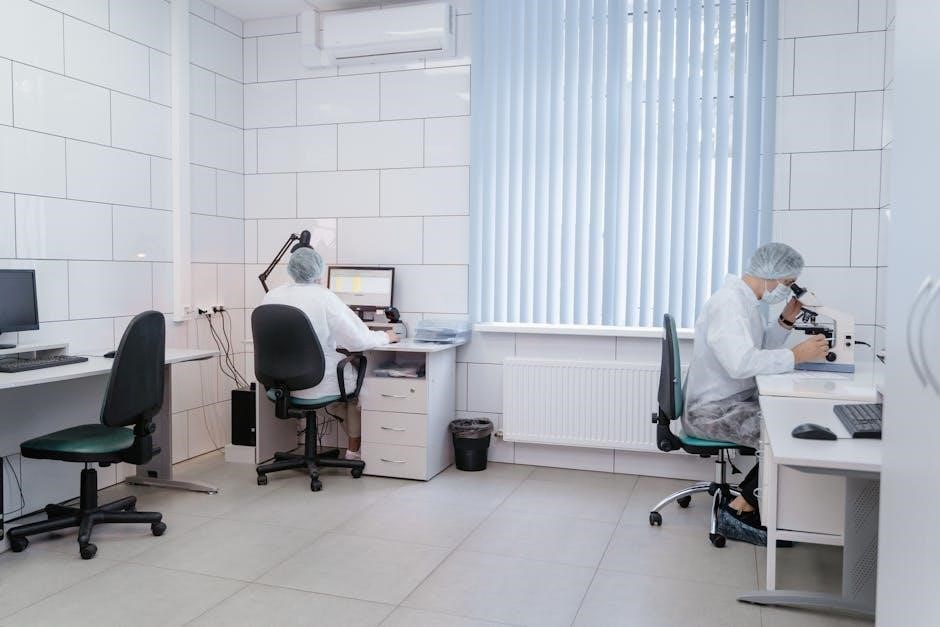The compound light microscope is a versatile tool in education and research‚ utilizing a combination of lenses for magnification. It is essential in biology and medicine for examining specimens‚ making it a cornerstone in scientific exploration and educational curricula.

1.1 Definition and Overview
The compound light microscope is an optical instrument that uses two or more lenses to magnify small objects or specimens. It consists of an eyepiece and an objective lens‚ which work together to produce a magnified image. The microscope is called “compound” because it uses a combination of lenses to enhance magnification and image clarity. Unlike a simple microscope‚ which uses only one lens‚ the compound microscope provides higher magnification and better resolution. This makes it an essential tool in biology‚ medicine‚ and education for studying microorganisms‚ cells‚ and other tiny structures. The microscope operates by transmitting light through a specimen‚ allowing users to observe detailed structures that are invisible to the naked eye. Its design and functionality have made it a fundamental instrument in scientific research and learning.
1.2 Importance in Science and Education
The compound light microscope is a cornerstone in scientific research and education‚ enabling the study of microscopic specimens with precision. Its ability to magnify tiny structures has revolutionized biology‚ medicine‚ and microscopy‚ making it indispensable for exploring cells‚ microorganisms‚ and tissues. In education‚ it serves as a hands-on tool for teaching students about cellular biology and the microscopic world‚ fostering scientific curiosity and skill development. Worksheets and educational resources on its parts and functions enhance learning‚ preparing students for careers in science and healthcare. Its accessibility and versatility make it a vital instrument in laboratories and classrooms‚ driving both discovery and understanding. The microscope’s impact on science and education remains unparalleled‚ ensuring its continued relevance in advancing knowledge and training future scientists.
1.3 Brief History and Development
The compound light microscope has a rich history dating back to the late 16th century‚ credited to Dutch spectacle makers who first combined lenses to magnify objects. Over centuries‚ it evolved with advancements in optics and design‚ becoming a critical tool in scientific discovery. Early versions were rudimentary‚ but improvements in lens grinding and illumination expanded its capabilities. By the 19th century‚ the microscope became a standard laboratory instrument‚ aiding in breakthroughs like the discovery of cells and microorganisms. Educational resources‚ such as worksheets on its parts and functions‚ emerged to teach students about its operation and significance. Its development revolutionized biology‚ medicine‚ and microscopy‚ making it an indispensable tool for both research and education.

Main Parts of the Compound Light Microscope
The compound light microscope consists of mechanical and optical parts. Mechanical parts include the base‚ arm‚ stage‚ and clips‚ providing stability. Optical parts‚ like the eyepiece and objective lenses‚ enable magnification and focus‚ ensuring clear image formation for precise observation.
2.1 Eyepiece
The eyepiece‚ also known as the ocular lens‚ is a critical optical component of the compound light microscope. Positioned at the top of the microscope‚ it is responsible for further magnifying the image produced by the objective lens. Typically‚ the eyepiece has a magnification power of 10x‚ though higher powers are available. It is designed to be interchangeable‚ allowing users to adjust the overall magnification of the microscope by pairing it with different objective lenses. The eyepiece works in conjunction with the objective lens to produce a clear‚ enlarged image of the specimen. Proper alignment and focus of the eyepiece are essential for achieving sharp‚ distortion-free images. Its design ensures comfort during extended use‚ making it a vital tool for detailed observations in both educational and research settings.
2.2 Objective Lenses
Objective lenses are a fundamental component of the compound light microscope‚ positioned near the specimen to focus light rays and form an image. These lenses are available in various magnifications‚ such as 4x‚ 10x‚ and 40x‚ allowing users to select the appropriate power based on the specimen’s size and detail requirements. The objective lens works in collaboration with the eyepiece to achieve the total magnification. Higher power objective lenses (e.g.‚ 40x and above) often require immersion oil to enhance resolution and clarity. Proper alignment and focusing of the objective lens are crucial for obtaining a sharp‚ well-illuminated image. This lens is essential for capturing the initial magnified image‚ which is then further enlarged by the eyepiece for detailed observation.
2.3 Stage and Stage Clips
The stage of a compound light microscope is a flat platform designed to hold the specimen in place during observation. It typically consists of a mechanical stage with clips to secure the slide‚ ensuring stability and precise positioning. The stage clips‚ often made of metal‚ gently grip the edges of the microscope slide‚ preventing movement and maintaining focus on the specimen. Some stages are equipped with adjustment knobs‚ allowing for precise movement of the slide along the x and y axes. This feature is particularly useful for navigating large specimens or locating specific areas of interest. The stage and its clips are essential for maintaining sample stability‚ which is critical for clear and accurate observations under magnification. Proper use of the stage and clips ensures that the specimen remains centered and secure throughout the examination process.
2.4 Coarse and Fine Adjustment Knobs
The coarse and fine adjustment knobs are essential for focusing the compound light microscope. The coarse adjustment knob is used to bring the specimen into approximate focus by moving the stage up or down. This knob is typically larger and located on the side of the microscope. Once initial focus is achieved‚ the fine adjustment knob is used to make precise adjustments‚ ensuring the specimen is sharply visible. The fine knob allows for minimal movement of the stage‚ enabling clear and detailed observations. Together‚ these knobs work in tandem to help users achieve optimal focus‚ making them indispensable for effective microscopy. Proper use of these knobs is critical for obtaining clear images and preventing damage to the microscope or the specimen. They are fundamental components in the everyday operation of the microscope.
2.5 Diaphragm and Condenser
The diaphragm and condenser are integral components of the compound light microscope‚ playing a crucial role in light control and image clarity. The diaphragm is located beneath the stage and consists of an adjustable aperture. It regulates the amount of light entering the microscope by varying the opening size‚ allowing for optimal illumination of the specimen. The condenser‚ positioned above the diaphragm‚ focuses the light onto the specimen‚ ensuring even distribution and improving resolution. Together‚ these components enhance the quality of the image by adjusting brightness and contrast. Proper alignment and adjustment of the condenser and diaphragm are essential for achieving sharp‚ clear images‚ making them vital for effective microscopy. They work in tandem to ensure that the specimen is illuminated adequately for accurate observations.
2.6 Light Source (Illuminator)
The light source‚ or illuminator‚ is a critical component of the compound light microscope‚ providing the necessary light for specimen observation. Typically located at the base of the microscope‚ it consists of a built-in light bulb‚ often an LED or halogen lamp‚ which emits a bright‚ even glow. The light source illuminates the specimen by directing light through the condenser and objective lens. Adjustments to the brightness can be made using the diaphragm and condenser‚ ensuring optimal illumination for clear image formation. Proper alignment of the light source is essential for maximizing resolution and minimizing glare. This component is fundamental for the microscope’s functionality‚ enabling users to study specimens in detail under controlled lighting conditions.
2.7 Arm and Base
The arm and base are structural components of the compound light microscope‚ providing stability and support. The base is the sturdy foundation that prevents the microscope from tipping over‚ ensuring steady operation. Attached to the base is the arm‚ a metal or durable material piece that connects the base to the microscope’s upper parts. The arm supports the entire framework‚ including the stage‚ focus knobs‚ and optical components‚ while allowing for smooth adjustment of the microscope’s position. This design ensures that the microscope remains stable during use‚ minimizing vibrations and movements that could disrupt observation. The arm and base are crucial for maintaining the microscope’s balance and are often constructed from robust materials to enhance durability and longevity.

Functions of Each Part
Each part of the compound light microscope serves a specific role in facilitating observation. The eyepiece and objective lenses work together to magnify specimens‚ while the stage and clips secure samples. The adjustment knobs focus the image‚ and the diaphragm regulates light intensity. The arm and base provide structural support‚ ensuring stability during use. Understanding these functions is essential for effective microscope operation in educational and laboratory settings.
3.1 Magnification and Image Formation
Magnification in a compound light microscope is achieved through a system of lenses. The objective lens collects light from the specimen‚ forming an image just outside its focal length. This image is then magnified by the eyepiece lens‚ creating a virtual image that appears enlarged to the viewer. The combination of these two lenses significantly increases the overall magnification power‚ allowing for detailed observation of microscopic structures. Proper alignment and focus ensure a clear and accurate image‚ making magnification a critical function in scientific exploration and education.
3.2 Focusing Mechanism
The focusing mechanism in a compound light microscope involves the coarse and fine adjustment knobs. The coarse adjustment knob is used to bring the specimen into approximate focus by moving the stage up or down. This process is typically done at lower magnifications to avoid damaging the slide or objective lens. Once the specimen is roughly in focus‚ the fine adjustment knob is used to make precise adjustments‚ ensuring the image is sharp and clear. Proper use of these knobs is essential for maintaining the integrity of the microscope and achieving accurate observations.
3.3 Illumination and Light Control
The compound light microscope relies on a well-designed illumination system to produce clear images. The light source‚ often a built-in illuminator‚ provides the necessary light‚ while the diaphragm regulates the amount of light entering the microscope. The condenser focuses this light onto the specimen‚ ensuring even illumination. Proper adjustment of the diaphragm and condenser is crucial for optimizing image clarity and contrast. This system allows users to control light intensity and focus it precisely‚ which is essential for observing detailed structures in specimens. Effective light control enhances the overall quality of the microscopic image‚ making it easier to study small samples accurately.
3.4 Sample Handling and Stability
The stage of the compound light microscope is designed to securely hold and position specimens for observation. It features stage clips that grip the edges of the slide‚ ensuring the sample remains steady during viewing. This stability is crucial for obtaining clear and focused images. The mechanical stage allows for precise movement of the specimen‚ enabling users to center and align it under the objective lens. Proper handling of the sample prevents damage to both the specimen and the microscope. The stage’s flat surface and secure clips ensure that the sample remains immobile‚ reducing vibrations and movements that could distort the image. This design ensures accurate and reliable microscopic examination‚ making it essential for scientific and educational applications.

How the Compound Light Microscope Works
The compound light microscope works by using objective and eyepiece lenses to magnify specimens. Light passes through the sample‚ focused by the objective lens and then magnified by the eyepiece for clear observation.
4.1 Light Path and Image Formation
The light path begins with the illuminator sending light through the condenser‚ focusing it onto the specimen. The objective lens then collects and magnifies this light‚ forming an intermediate image. This image is further enlarged by the eyepiece lens‚ creating the final magnified view seen by the user. Proper alignment of the condenser and objective ensures a clear‚ bright image. Misalignment can lead to dark or distorted images‚ emphasizing the importance of correct setup and adjustment. This process relies on the precise interaction of optical components to deliver accurate specimen visualization‚ making it fundamental to microscopy.
4.2 Role of Lenses in Magnification
The compound light microscope relies on two key lenses for magnification: the objective lens and the eyepiece lens. The objective lens‚ located near the specimen‚ collects light and forms an intermediate image. The eyepiece lens then enlarges this intermediate image further‚ creating the final magnified view. The objective lens typically has lower magnification (e.g.‚ 4x‚ 10x) but higher resolution‚ while the eyepiece lens (usually 10x or 40x) provides additional enlargement. The total magnification is the product of the objective and eyepiece magnifications. This dual-lens system ensures high-resolution imaging and precise focus‚ enabling users to observe microscopic details with clarity and accuracy.
4.3 Adjusting Focus and Brightness
Adjusting focus and brightness is crucial for clear observation under a compound light microscope. The coarse adjustment knob is used to bring the specimen into rough focus‚ moving the stage up or down. Once initial focus is achieved‚ the fine adjustment knob refines the image for clarity. For brightness‚ the light source’s intensity is controlled by the diaphragm and condenser. The diaphragm regulates the amount of light entering the stage‚ while the condenser focuses the light onto the specimen. Proper adjustment ensures optimal illumination and image quality. Incorrect use of these controls can result in a blurry or overly bright image‚ making it difficult to observe details accurately. Always adjust focus and brightness carefully to maintain the integrity of the microscope and the quality of the image.

Worksheets and Educational Resources
Educational resources‚ such as worksheets and labeled diagrams‚ help students identify microscope parts and understand their functions. Practice exercises and interactive activities enhance learning and retention effectively.
5.1 Identifying Parts of the Microscope
Identifying the parts of a compound light microscope is a fundamental step in understanding its operation and functions. Worksheets and educational resources‚ such as labeled diagrams and matching exercises‚ help students recognize components like the eyepiece‚ objective lenses‚ stage‚ and adjustment knobs. These tools often include word banks and letter-matching activities to associate each part with its function. Interactive activities‚ such as drag-and-drop games or fill-in-the-blank exercises‚ make learning engaging and effective. By mastering this skill‚ students can confidently navigate microscope usage‚ laying a strong foundation for practical laboratory work and scientific exploration. These resources are particularly valuable in educational settings‚ ensuring learners develop both theoretical knowledge and hands-on proficiency with the microscope.
5.2 Matching Functions to Parts
Matching functions to parts of the compound light microscope enhances understanding of its operational components. Worksheets often include exercises where students link specific functions‚ such as magnification or focusing‚ to their corresponding parts‚ like the eyepiece or adjustment knobs. These activities utilize word banks and diagrams to guide learners in associating each microscope element with its role. For example‚ identifying that the eyepiece provides initial magnification or that the diaphragm controls light intensity. Such exercises ensure a comprehensive grasp of how each part contributes to the microscope’s overall functionality. By engaging with these resources‚ students develop a clear connection between the physical components and their practical applications‚ fostering a deeper appreciation of microscopy principles and their real-world applications in scientific research and education.
5.3 Practice Problems and Exercises
Practice problems and exercises are essential for reinforcing knowledge of microscope parts and their functions. Worksheets often include numerical problems‚ such as calculating total magnification using eyepiece and objective lens powers. Students may also label diagrams‚ matching terms like “eyepiece” or “condenser” to their respective locations. Additionally‚ exercises might involve scenario-based questions‚ such as determining the correct adjustment knob to focus a blurry image or explaining how to improve illumination. These activities help students apply theoretical knowledge to practical situations‚ ensuring a thorough understanding of microscope operation and its applications in scientific exploration. By solving these problems‚ learners develop critical thinking and troubleshooting skills‚ which are vital for effective microscopy in both academic and professional settings.

Compound vs. Simple Microscope
The compound microscope uses two lenses for higher magnification‚ while the simple microscope uses one lens‚ offering lower magnification. This difference defines their practical applications in microscopy.
6.1 Key Differences
The compound microscope is distinguished by its use of multiple lenses‚ providing higher magnification compared to the simple microscope. It includes an eyepiece and objective lenses‚ enabling detailed specimen observation. In contrast‚ the simple microscope relies on a single magnifying lens‚ limiting its resolution. The compound microscope also features adjustable focus and illumination controls‚ enhancing its functionality. Its complex optical system allows for greater versatility in scientific applications‚ making it a preferred tool in professional settings. These advancements in design and functionality set the compound microscope apart from its simpler counterpart‚ catering to more intricate and demanding microscopic studies across various fields.
6.2 Why It’s Called a Compound Microscope
The compound microscope earns its name from its use of multiple lenses combined to achieve higher magnification. Unlike simple microscopes‚ which use a single lens‚ the compound microscope employs both eyepiece and objective lenses. This dual-lens system significantly enhances image resolution and magnifying power‚ allowing for detailed observation of specimens. The term “compound” refers to the combination of these optical elements‚ which work together to produce a magnified image. This design advancement was pivotal in microscopy‚ enabling scientists to study microscopic structures with greater precision. The compound microscope’s name reflects its complex yet efficient optical system‚ distinguishing it from earlier‚ less powerful microscopes.

